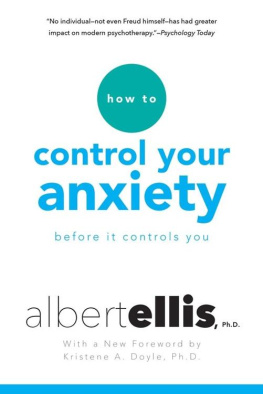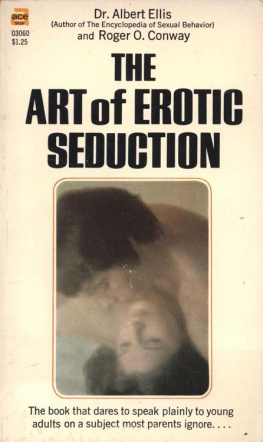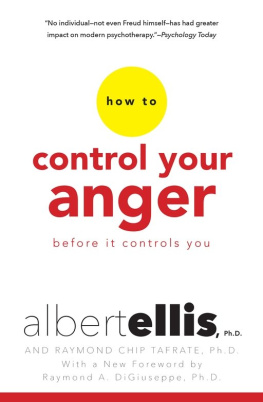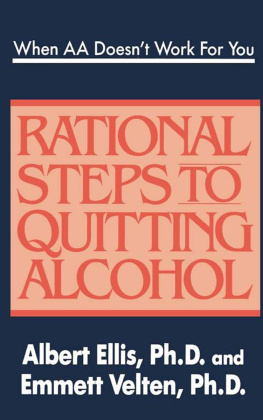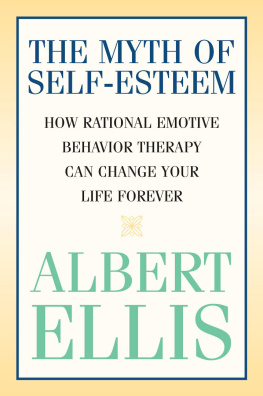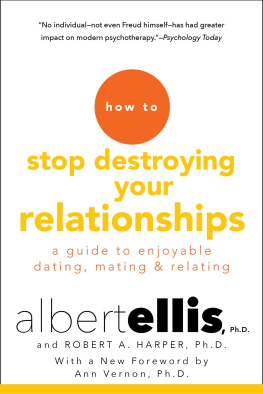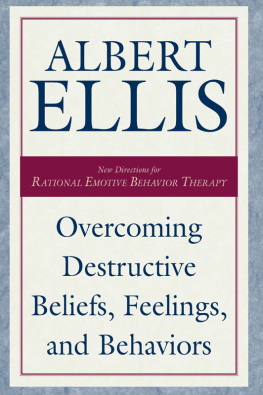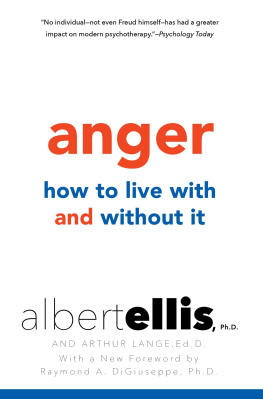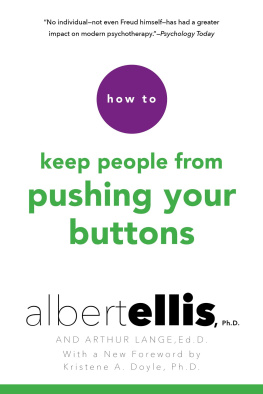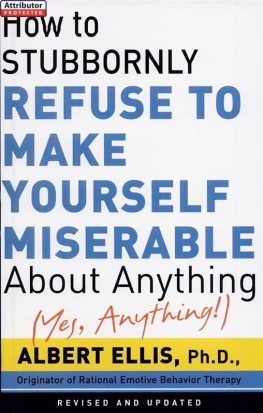CHAPTER 1
THE ORIGINS OF RATIONAL
EMOTIVE PSYCHOTHERAPY
EDITORS COMMENTARY:
Albert Ellis began a classical psychoanalysis in the very early 1950s at the HorneyInstitute in Manhattan. From other sources, it was known that his analysts name wasHeulbeck. Upon completion of his training, Ellis saw patients in a classical way, forexample three times per week with the analyst sitting out of view and behind the patient.According to Ellis, patients reported that they understood insights but seemed often notto carry those insights into consequent sessions. Therefore, he started to experiment byshortening the number of interventions per week, usually to one session. Ellis also satface-to-face with his patients so that he was ready to be active. Ellis concluded that less wasbetter: when he saw patients less often, they seemed to do better (he offered some percentageestimates of improvement).
A shift by Ellis from psychoanalysis and psychoanalytically oriented psychotherapytook place when he used the analogy of learning theory. He saw that psychoanalysis wasbased upon a conditioning model, and so Ellis went to it directly.
Apparently, he arrived at this conclusion about five years before Truax did, accordingto the counseling literature. He also saw how avoidance was a reinforcement for neurosisin his patients. Yet, Pavlovs theory did not fit most human experiences since dogs were notadvantaged with human language. It was human language, argued Ellis, that could serveas a vehicle to transport reward or punishment cues. By 1954, Ellis had concluded thathumans could learn fear cues from their own language self-signaling, and that signalingoften represented the opinions of other people, parents, teachers, chance meetings, and thelike. Instead of the unconscious clueing humans to be negatively auto-suggestive, El isargued that a negative or neurotic style resided within auto-suggestive language that, withsome work, could be made conscious. Thus, learning theory was an interim step in theorydevelopment between psychoanalysis and rational-emotive interventions.
Ellis also began to see clearly the attachment children developed toward irrationalappraisals of life and its changes, thanks to parents and others who functioned within agiven childs scope of reference. Not only did children learn to invest their learned behaviorwithin language with negative emotions, but they stubbornly and steadfastly clung to them.It was the re-indoctrination of self-defeating irrationalities, however, that kept a persondisturbed into his or her adult years, and this factor often loomed as more important interms of disturbance than the originally learned disturbance. Therefore, people could makethemselves disturbed at any age, but they hardly did so on purpose. In a case examplewhere a woman did not get along with her husband (she had attributed the lack of gettingalong to having been deprecated by her father when she was younger), Ellis showed thepatient that her lack of feeling good about herself came from her belief that she had beena rotten person. Ellis argued that she could have been role rotten, but not a totally rottenperson, and the woman changed her beliefs and started to feel better. It was the patient whoconcluded that she kept telling herself unavoidable negative sentences so that it was her ownsentences that continued to disturb her and not her father, her husband, or her relationship.The patient felt better when she disputed and replaced her own indoctrinating sentences.By the beginning of 1955, then, the theory of rational-emotive therapy had been prettywell formulated.
Excerpted from Reason and Emotion in Psychotherapy,
Lyle Stuart, Inc. 1962
Rational-emotive psychotherapy (often called, for short, rational therapy or RT) was born the hard way. My original training as a psychotherapist had been in the field of marriage, family, and sex counseling: where treatment largely consists of helping individuals with specific marital and sexual problems by authoritatively giving them salient information about how to handle each other, how to copulate effectively, how to rear their children, and so on. This kind of therapy seemed to work fairlyand sometimes surprisingly well. But it had its obvious limitations, since it quickly became clear to me that in most instances disturbed marriages (or premarital relationships) were a product of disturbed spouses; and that if people were truly to be helped to live happily with each other they would first have to be shown how they could live peacefully with themselves.
So I embarked on a course of intensive psychoanalytic training. I had been highly conversant with all of Freuds main works, and with many of those of his chief followers, ever since my early years in college (when I had practically lived in the old Russell Sage Library at 22nd Street and Lexington Avenue, a block away from the downtown branch of the City College of New York, where I was then a student).
Although, from the very start, I had many reservations about Freuds theory of personality (since, even at the age of seventeen, it was not too difficult for me to see that the man was brilliantly creating clinical interpretations to make them fit the procrustean bed of his enormously one-sided Oedipal theories), I somehow, perhaps by sheer wishful thinking, retained my belief in the efficacy of orthodox psychoanalytic technique.
I believed, in other words, that though nonanalytic methods of psychotherapy were often helpful and much less time-consuming than classical analytic methods, the latter were indubitably deeper, more penetrating, and hence considerably more curative. So I very willingly underwent an orthodox psychoanalysis myself, with a highly respectable training analyst of the Horney group, who had been a Freudian analyst for twenty-five years prior to his affiliation with the Horney school, and who also had sympathetic leanings toward some of the main Jungian teachings. For all his theoretical eclecticism, however, his analytic technique was almost entirely Freudian; with the result that I spent the next three years on the sofa, with my analyst for the most part sitting silently behind me, while I engaged in free association, brought forth hundreds of dreams to be interpreted, and endlessly discussed the transference connections between my childhood relations with my mother, father, sister, and brother, on the one hand, and my present sex, love, family, professional, and analytic relations on the other.
Both I and my analyst considered my analysis to have been successfully completed; and at his suggestion I went on to complete several control cases: that is, to work, under the supervision of a training analyst, with my own patients, with whom I consistently employed the sofa, free association, extensive dream analysis, and resolution of the transference neurosis. During this period, although I saw some marriage and family counseling clients with whom I did not attempt psychoanalysis, I routinely put all my regular psychotherapy patients on the sofa and proceeded with them in a decidedly orthodox psychoanalytic way.
Unfortunately, the miracle of depth therapy, which I had confidently expected to achieve through this analytic procedure, never quite materialized. I think that I can confidently say that I was a good young psychoanalyst at this time. Certainly, my patients thought so and kept referring their friends and associates to me. And my therapeutic results were, as far as I could see, at least as good as those of other New York analysts.


